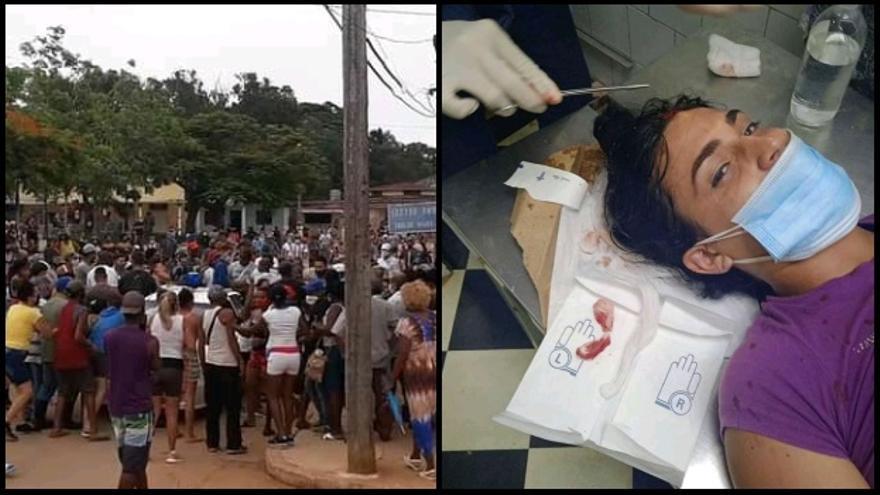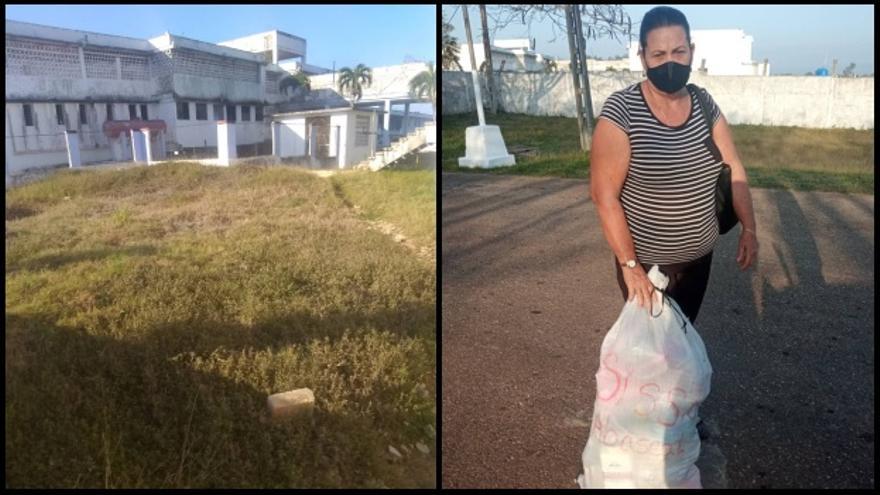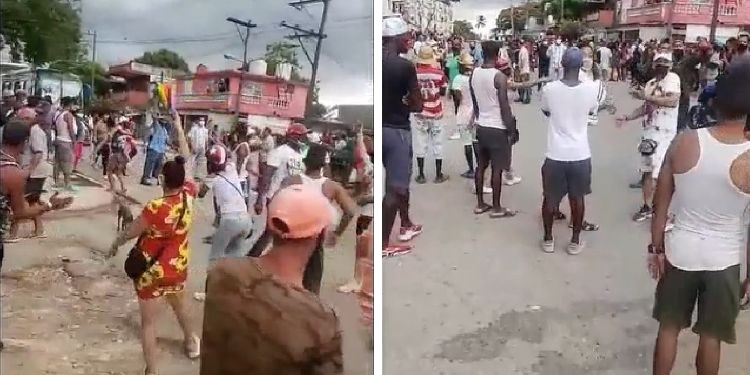At the age of 16, Sissi Abascal Zamora was not, like any teenager, walking with her friends or wearing new clothes. At that age she became part of the Ladies in White Movement and she lived between arrests and police operations. On July 11, 2021, her participation in the popular protests that day led her to prison with a six-year sentence.
Her mother, Annia Zamora Carmenate, has no doubts: “Sissi is a political prisoner.” From that quiet girl, who differed from her brothers for being very calm, she became one of the most constant activists in the province of Matanzas. In the little town of Carlos Rojas, the young woman – on 11J she was 23 years old – she starred in an intense demonstration together with dozens of neighbors.
“That day we were at home and I connected to the internet through my cell phone. That’s when I started watching the videos of the demonstrations, first in San Antonio de los Baños and then in Havana, so I told my husband, Armando Abascal Serrano “, details Zamora to 14ymedio. “Then Sissi tells me that people were gathering for the Carlos Rojas park.”
The family lives on the outskirts of the town and when they got out on the road there were already other people waiting for them. “They know that on other occasions we have also protested.” In November 2020, the Abascal family was part of the group of residents of that community, belonging to the Jovellanos municipality, who demonstrated in the streets against the long blackouts.
Long before, saying the surname Abascal among neighbors is like remembering that the first name of the town was Cimarrones
Long before, saying the surname Abascal among the neighbors is like remembering that the first name of the town was Cimarrones, for the slaves who did not accept the stocks or the whip of the foreman and escaped to their surrounding mountains. Although these rebels of today are not facing slavers with dogs, but policemen who brandish the tonfa and lock them up in dungeons.
“We kept going and arrived at the park. That was tremendous. Everyone joined in. Right away, two State Security officers appeared and took my husband to the station in front of the park.” The arrest emboldened the protesters. “We were joined by people that we had never seen in other demonstrations we’ve done.”
Sissi climbed onto a bench, “suddenly a sheet appeared. We put it on the sidewalk and wrote ‘Patria y Vida’ on it.” She took off her shoelaces and I gave her mine too. With that we tie the fabric to a flamboyant branch on one side and on the other we put a crutch. We climbed the sign on a bicycle and started to go around the park.”
That month of July the town of Carlos Rojas, like the whole Island, was experiencing critical days. “In the municipality of Jovellanos there was a very intense outbreak of covid-19, we had no medication, the isolation centers had very poor conditions,” Zamora recalls. The lack of freedoms was combined with the economic crisis and the epidemiological situation. That Sunday patience reached the limit.
Zamora closes his eyes and seems to be living that day again. “The people gathered in the park shouted food! Freedom! Down with the dictatorship! We want medicines”, also “homeland and life!, that slogan was the one that was repeated the most. that will go down in history: there were old people, children and many young people too”.
Then the patrol arrived to transfer Armando Abascal Serrano from the town station to Jovellanos. “People stood in front of the vehicle to prevent it, but the police dealt many blows and finally took it away,” he says. The rest of the afternoon, those who remained continued to repeat slogans until around 6:30 pm a bus and a truck with shock troops arrived.
“In the bus and the truck were Yonaikis Villegas Oviedo, the mayor of Jovellanos, also the representative of the Communist Party, the director of the Inder (National Institute of Sports, Physical Education and Recreation), members of the political police dressed in civilian clothes, of the Government, the Party and the head of Communals”, lists the mother.
“They came with sticks and stones in their hands, later we learned that they were even carrying bottles. It was a very strong aggression. They hit me and I fell against the bicycle that held the sheet, Sissi fell on me.” Zamora adds that the Communal official attacked her in the head, eyes, arms and her belly. “I had just had surgery and I fainted, so I stopped seeing my daughters.”
When he came to, he heard someone yelling at him that Lisi, his other daughter, was injured after receiving several bottle blows to the head. Her mother ran to the Polyclinic and on the way she dropped the shoes, whose laces had helped tie the sign. There she found her daughter, who was having her head bandaged. She “she also had a hand with the fingers turned backwards that the orthopedist had to put them back forwards.”
Shortly after, she also arrived at the Sissi Polyclinic beaten. Half an hour later the three women were transferred in an ambulance to Jovellanos. “There were many injured there because the police had distributed many blows. They gave my daughter Lisi a certificate of injuries, because they had to give her stitches on the head wound, but they did not want to give Sissi and me anything.”
That day they were able to return home and on Tuesday, July 13, they went to the municipal police station to file a complaint for the injuries against Lisi. “Even today, ten months later, neither the police nor the Prosecutor’s Office give details, they always evade,” laments Zamora.
The family patriarch was missing for 14 days. “We took him some clothes to the Jovellanos police station and they stole it, they never gave it to him. He was imprisoned for two months in the Combinado del Sur and then he was fined,” explains the woman. “On September 20 in the morning, an official from the Municipal Court of Jovellanos arrived and she knocked on the door of our house. She had in her hands a six-year tax petition against Sissi.”
The trial took place on November 3. In the process, they judged not only the young woman, but also Frank Ernesto Trujillo Hervis and Yoendris Torres Corría, 11J protesters. “Frank, when my daughter was being beaten, he took her out of the group of women. He is now sentenced to six years in prison.”
At the trial in the Municipal Court of Jovellanos, Zamora attended as a witness: “I went in, made my statement and then I could only return to hear the conclusions. It almost gave me a heart attack to hear so many lies. The prosecutor Odilia Casallas García lied blatantly. She said that since 1959 no one had been mistreated and beaten by the police in Cuba”.
Sissi’s sister couldn’t stand that, she got up from her seat and denied the Prosecutor. “Our family has been hit many times. I still have stitches on my head from being hit with a bottle.” Immediately the guards took her out of the room.
The mayor of the Ministry of the Interior, Silvia Martínez Montero, accused Sissi of attack and contempt, although the family assures that this officer was not present on Sunday in the Carlos Rojas park. “The trial was a farce, a clown. Not even the defense attorneys could do their job,” Zamora denounces.
The appeal trial was held on December 27, under an intense security operation, and the sentence of six years in prison was confirmed. The young woman was confined in the Matanzas women’s prison, Labiotec. “It’s a nasty, sad place. It has two buildings and she’s in one of them in cubicle three on the third floor.”
But during the phone calls, the young woman’s great concern is not the prison conditions but her family. To calm her mother, she reiterates: “Don’t worry, remember how many dungeons, beatings and detentions I have experienced.” She also wants to know details of the other prisoners of that historic day of protests.
When Annia Zamora Carmenate asks her daughter what she wants her to bring in the food bag that she tries to prepare for each visit, the young woman asks for little or nothing. Although her mother insists, she responds in monosyllables. In those moments, she returns to being the shy and quiet girl from the town of Carlos Rojas.
________________________
Collaborate with our work:
The team of 14ymedio is committed to doing serious journalism that reflects the reality of deep Cuba. Thank you for joining us on this long road. We invite you to continue supporting us, but this time becoming a member of our journal. Together we can continue transforming journalism in Cuba.










